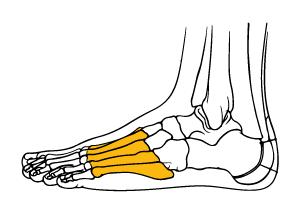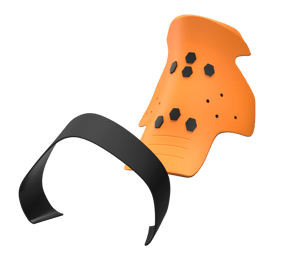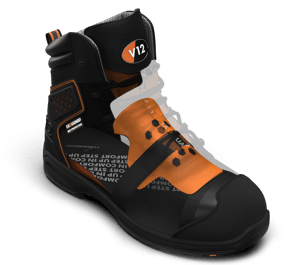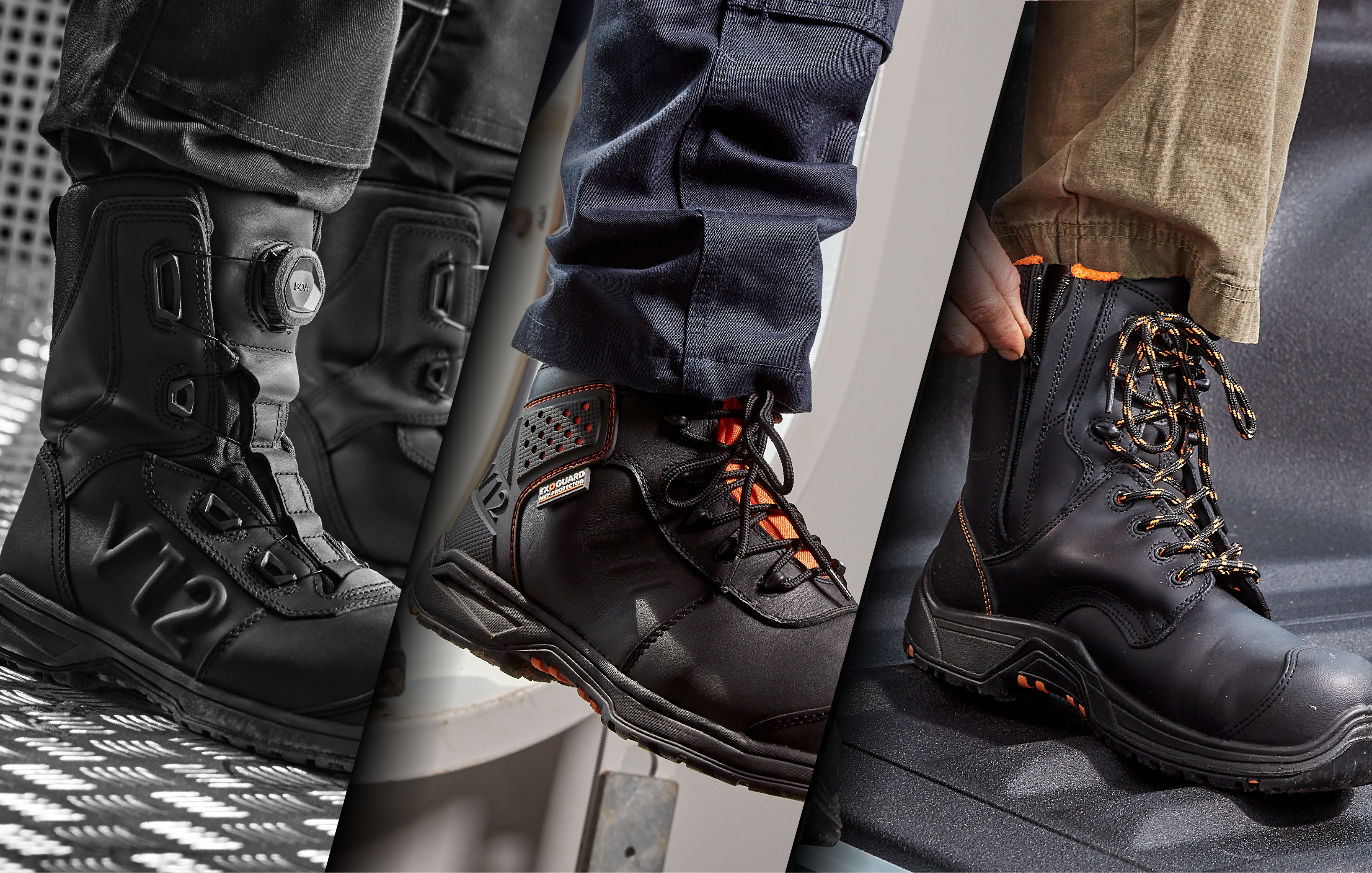There are all kinds of safety boots out there for multiple industries and applications, and it’s easy to get lost in the many features being offered. And in the long list of safety specs available, some are fairly familiar: waterproof, toe and midsole protection, anti-static and slip-rated soles. But what about met protection?
In this piece, we’ll illustrate what a met boot does and whether you might need to be wearing a pair at work. We'll also introduce you to our groundbreaking new met boot 'Invincible' and show you how it uses pioneering technology to give never- before-seen metatarsal protection.
WHAT IS A MET BOOT?
A met boot is short for metatarsal boot. Metatarsals are the long bones connecting your toes to your ankles that are key in helping us balance when walking, standing or running.
(Quick English lesson: Your tarsals are just below your ankle, and the word ‘meta’ is Greek for ‘beyond,’ so the bones after the tarsals are called ‘metatarsals’.)
So, a met boot is a boot that aims to protect these bones. And the word ‘aim’ is important here, because while a lot of boots pass the metatarsal safety test, not all of them do it consistently.
WHY DO YOUR METATARSALS NEED PROTECTING?
The reason your metatarsals aren’t difficult to find is because they're not protected by muscle – they sit beneath a very thin layer of skin. They're also relatively thin bones, and so easily fractured if on the receiving end of a heavy object. Finally, they’re vulnerable because they’re part of your foot – and the pesky thing about feet is that they stick out beyond the body line, leaving them - just like the toes - more at risk of breaking.
WHAT ARE THE EFFECTS OF METATARSAL INJURIES?
A metatarsal fracture is extremely painful. But it also involves:
- Bruising
- Swelling
- Inability to weight bear
- Reduced ability to drive
- Time off work and potential loss of income
Healing from a metatarsal injury can take from 6 to 8 weeks. However, if a broken metatarsal doesn't heal properly (known as a ‘non-union’) this can mean months rather than weeks of pain and healing time, more absence from work - and surgery may also be required.
And if you’ve sustained a metatarsal injury, you probably didn’t get it sending an email or filling in a spreadsheet. The chances are you were on site, facing the hazards that your industry poses to you every day. And because of this it’s highly unlikely you’ll be able to do your job effectively while hobbling around on crutches. If your job requires you to be on your feet or lifting heavy equipment, with a metatarsal injury - you’ll be staying home for quite a while.
Furthermore, the location of the metatarsals doesn't just make them more vulnerable to an accident - in many cases, it makes them a slower and more painful bone to heal.
“Due to the location of the metatarsals, pain or bruising can persist for longer as they’re part of such a functional element of the body. The pressure that goes through the metatarsals from everyday activities like standing and walking is difficult to limit. So this can lead to increased pain and healing time, which impacts quality of life and ability to work.”
Nina, NHS physiotherapist
HOW ARE METATARSAL BOOTS TESTED?
The met protection test is tough to pass. At the start of the test, a wax foot shape is placed inside the boot. Then, a 20 kg weight – or striker – is dropped from a distance of half a meter onto the metatarsal area of the boot. If the striker makes an indentation in the wax past a certain measurement, the boot fails the test as it hasn’t adequately protected that area.
WHAT ARE THE PROBLEMS SURROUNDING A LOT OF MET BOOTS?
- It is a big challenge to create a met boot that consistently passes the safety test because the metatarsal guard has to be an extremely strong piece of material that stays in the same shape and position. However, this guard is protecting a constantly moving and changing structure – the foot. So it can be a demanding task for any manufacturer to make a boot that has to be simultaneously flexible and rigid.
- Many metatarsal boots can be heavy due to the added weight of the protective met guard material, which can cause foot drop and lower limb fatigue. To add to this, met boots should always have a safety toe cap, so this steel or composite feature adds more weight to an already bulky boot.
TYPES OF MET BOOTS
There are two types of met boots. External and internal. Let’s talk pros and cons:
External
- Pros: A lot of metatarsal boots have detachable external met guards, which offer effective protection for the laces.
- Cons: An external met guard can catch on protruding objects, which is a big trip risk, and external metatarsal guards are often steel – so this means limited boot flexibility, particularly for those regularly kneeling, operating pedals or using ladders.
Internal
- Pros: Because internal met guards are inside the boot, they're often smaller and thinner, offering more flexibility for the wearer.
- Cons: Some wearers feel that a larger protective layer outside of the boot is more effective at taking the impact of a heavy falling object (although developing technology does mean that the material used for internal met guards is just as strong as a lot of their external counterparts).
I WEAR SAFETY BOOTS FOR WORK - DO I NEED A MET BOOT?
You might – but it depends on what type of hazards you work with. Those working in the following occupations will find wearing a met boot a huge safety bonus:
- Road construction
- Demolition
- Welding
- Sewer maintenance
- Any role that involves heavy rolling or falling objects or materials such as drums, wheels, drain covers or aggregate.
INVINCIBLE – THE NEXT LEVEL OF MET PROTECTION
-1.png?width=2492&name=V12%20Footwear_Invincible_Email%20Header%20(1)-1.png)
The V2180 Invincible IGS is a different kind of met boot. It’s a truly revolutionary piece of safety footwear, using industry-leading technology to provide never-before-seen metatarsal protection.

EXOGUARD® - PIONEERING PROTECTION
What sets Invincible IGS apart from other met boots is its patented ExoGuard® protection system.
At the heart of ExoGuard® is the internal carbon strap. This material features graphene mixed with resin and is over 200 times stronger than steel and arches over the middle of the foot, safeguarding the metatarsals with supreme strength.
The ExoGuard® system also features a dual density compound pad, further protecting the metatarsals by dispersing the energy of any impact with highly effective shock absorption.
Check out the video below for a more in-depth look into the awesome protective capabilities of the Invincible IGS.
PROTECTION YOU CAN COUNT ON
V12 are committed to providing the safest solution for its wearers. Everything we do is focussed on ensuring those wearing our footwear return to their homes and families having been fully protected from the hazards of their industry. And this is why we’ve built the Invincible with revolutionary technology – so our wearers can enjoy supreme metatarsal protection that can be counted on. And its performance in the met protection test shows this clearly - the Invincible IGS didn’t just pass the test – it consistently passed it.
Men and true WOMEN'S-FIT
This revolutionary safety style is available in a true women's fit (V2185 Invincible IGS) and a male-fit (V2180 Invincible IGS), both offering the same stronger-than-steel metatarsal protection, but both built on specifically designed lasts to support and contour a woman's and man's foot shape.
Women's feet are a different shape and structure to men's, and these essential anatomical differences are reflected in the V2185 Invincible IGS, so wearers get total comfort and full protection - no exceptions.

The Wearer Trial Feedback
We ensured that our trusty test pilots trialled the boots in the environments they will be worn in day in, day out - and Invincible proved to be a winner in every department. The boot scored, on average, a seriously impressive 4.8 out of 5 by our trial wearers, and also notched up an outstanding 4 out of 5 for fit and slip resistance.
Futuristic footwear
Invincible also features advanced nanotechnology in the toe cap, meaning the end of the boot is:
- lightweight, providing even weight distribution thus reducing fatigue
- thinner, allowing increased toe room and a more comfortable fit
- slower to conduct heat or cold, so the wearer can work in hot or cold temperatures
- non-metallic, so it won’t set off metal detectors or alarms
Along with V12’s IGSTM sole unit, advanced ankle protection, protective midsole and scuff-resistant toe and heel, the fully waterproof Invincible means that next level met protection is here.

.png)



